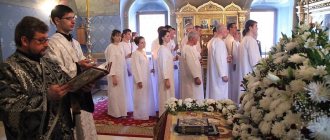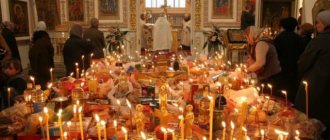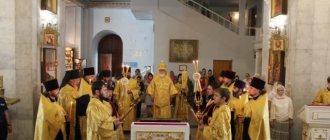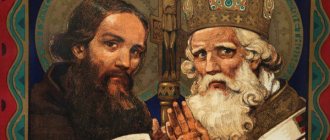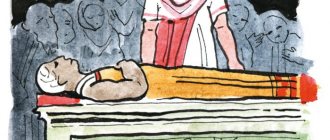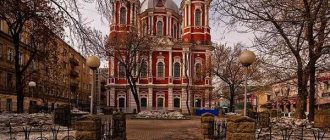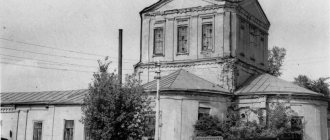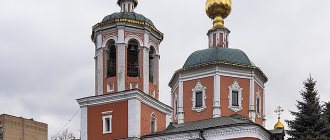Churches and other organizations of the Russian Orthodox Church at the beginning of the twentieth century (before 1917)
M.Yu. Smirnov, DYNAMICS OF RELIGIOUS ORGANIZATIONS IN PRE-REVOLUTIONARY RUSSIA: historical and statistical review, Part 9
Revolutionary events of the early twentieth century. The church body was not spared. The highest clergy revealed a clear clerical bias, and the parish clergy became noticeably politicized. In the First State Duma, all the priests elected there joined the left and the center, and the two elected bishops joined the right factions. In the Second Duma, both bishops supported the right and the Octobrists; among the 20 elected priests there were three Cadets, four Socialist Revolutionaries, four joined the right. In the Third Duma, four priests joined the centrist faction, nine joined the Octobrist faction, 13 priests and one bishop joined the moderate right faction, two joined the nationalists, one archbishop and 15 priests joined the right-wing monarchists. There were already 46 clergy in the Fourth Duma, of which six priests belonged to the centrists, 19 were moderate right-wingers, and another 19 and both bishops joined the extreme right.
In 1905, the Russian Orthodox Church had 66 dioceses, 48,375 cathedrals and parish churches, 20,583 chapels and houses of worship; the clergy (including the lower clergy) numbered more than 103 thousand people; clergy personnel were trained in 4 theological academies, 57 theological seminaries, 184 men's theological schools; there were also 74 women's schools of the ecclesiastical department (of which 61 were diocesan); There were 860 monasteries (67,720 monastics and novices).
The composition of the monasteries was of different levels. Large ones stood out - four laurels (Trinity-Sergius, Alexander Nevskaya, Kiev-Pecherskaya, Pochaevskaya), seven stauropegial monasteries. Along with hundreds of “averagely populated” monasteries, there were also relatively small ones in terms of the number of monastics: deserts - 86 (12), monasteries - 68 (13), cenovia - four. Until the beginning of the twentieth century. 20 male and 10 female monasteries simultaneously served as places of detention. They were released from this function only in 1905–1907. The largest and oldest (since 1554) monastery prison was Solovetskaya (closed in 1902). From the circus. lyric decrees of the Synod for 1867–1900. It followed that church officials alone were exiled to monasteries annually for various offenses, on average up to 900 people.
Statistics of land ownership for 50 provinces of central Russia indicate that on their territory at the beginning of the 20th century. Orthodox monasteries owned 739,777 acres of land (the Solovetsky Monastery had 66 thousand acres of land, the Alexander Nevsky Lavra - 13 thousand acres, the Trinity-Sergius Lavra - 2 thousand acres). More than 1.8 million dessiatines were owned by churches, 337 thousand dessiatines belonged to members of the clergy as private property. The total size of church land ownership in 1905 was 2,611,636 dessiatines.
The maintenance of the Orthodox clergy consisted of regular salaries, funds from the fulfillment of requirements, income from land holdings, and voluntary donations from the flock. The financial policy of the Russian state also contributed to the strengthening of church opportunities. A procedure for permanent benefits to clergy was in effect. In 1905, the clergy of 27,412 churches received them; in 1907, the clergy of 38,413 parish churches received 12.3 million rubles from the state treasury. 115 By 1914 The annual state subsidy to the Church amounted to 18 million rubles. According to other sources, state allocations for the needs of the Orthodox Church amounted to 29.3 million rubles in 1905, and in 1914 they rose to 53.9 million rubles. 117 Total revenues from all sources for 1914, according to the Synod’s estimates, reached 110.3 million rubles. At the same time, the Holy Synod did not publish reports on its expenses, and the reports of the chief prosecutors contained only isolated data.
Of particular relevance for the Church at the turn of the 19th and 20th centuries. had professional training for priests and theologians: the available level clearly lagged behind the aggravated demands of the time. For 1900–1910 all four theological academies graduated more than 1,600 people, but by 1911 only 700 priests with academic education served in parishes and non-parish churches. Many “academicians” went to secular service. The seminar environment experienced the revolutionary sentiments of the early twentieth century. In 1905, strikes took place in 18 theological seminaries. The number of students in theological educational institutions did not change significantly over the course of 20 years: in 1894 - 901 people in academies, 18,749 - in seminaries, 30,896 - in theological schools; for 1910, respectively - 903, 21,075, 28,124; for 1914 - 995, 22,734, 29,419 people. The number of teachers in theological seminaries decreased from 1091 in 1894 to 947 in 1914. At the same time, however, subsidies from the treasury for institutions of theological education increased: in 1894 they amounted to 1,619,318 rubles, and in 1913 already RUB 3,299,404 (the Synod’s expenses in this area in 1905–1913 amounted to 5–6 million rubles annually).
In 1912, there were 53,902 churches and 23,204 chapels with a clergy totaling 110,970 people; in 985 monasteries there were 86,854 monastics and novices 122. During the first 17 years of the 20th century. 177 new monasteries were founded. Income. bishops' houses, laurels and monasteries also increased. According to V.V.’s calculations Morozan, by January 1, 1910 they owned 61 million rubles. in securities and about 1.4 million rubles. in cash; 21.5 million rubles were added to this. total income from mug collection, sale of candles, rent collection, interest on capital in banks, donations from parishioners, etc., as well as 1 million rubles received from the treasury for their annual maintenance. In 1913 the amount of monastery bank deposits amounted to 65.6 million rubles. In 1910, the monastery operated 202 hospitals and 104 almshouses; by 1914, this number had grown to 234 hospitals (2,698 beds) and 169 almshouses (2,252 beds); during the First World War, according to P.N. Zyryanov, infirmaries were opened in 207 monasteries (of which 139 were actually monasteries). State. support for this area continued during wartime: in 1916, for example, 275 monasteries received another 423.5 thousand rubles in addition to their own income. government content.
The statistical characteristics of the Orthodox Russian Church at the final stage of the synodal period of its history (1914–1917) present some complexity. On the one hand, there are various church and state documents, according to which the picture should look relatively complete and close to authenticity. On the other hand, an accurate accounting of the actual state of the Church in the mentioned period was already complicated by the ongoing socio-political events and was far from possible in everything. In Soviet times, the attitude to statistical information was often arbitrary and selective, and much was simply lost. Data disseminated in domestic publications, even based on identical sources, often differ markedly. From these materials, in a brief generalized form, the position of Orthodox church organizations is presented as follows.
Regarding the size of the Orthodox flock at the time in question, one has to rely only on formal quantitative data. According to a modern domestic researcher, “... in pre-revolutionary Russia, characterizing the state of religiosity in society was the prerogative of state statistics bodies.” Belonging to any religion was recorded on the basis of church registration of births and baptisms for Christians or corresponding acts adopted for non-Christian religions. Such identification did not take into account either the level of religiosity (whether the person remained a practicing believer or did not observe religious institutions), or the possible non-denominational state of being “enrolled” in a confession.
Magazine “State, Religion, Church in Russia and Abroad”, No. 3 2010
www.gazetaprotestant.ru
Patriarchs of the 20th century
Professor of the St. Petersburg Theological Academy,
Head of the Department of Church History, SPbDA
Archpriest Georgy Mitrofanov
Lecture series
"Russian Orthodox Church of the twentieth century
in the personalities of the Patriarchs"
Reports by Alexander Ratnikov from the lecture hall of the Feodorovsky Cathedral (2010)
15 programs on radio “Grad Petrov”
AUDIO + TEXT
Gear 5
After his release, Patriarch Tikhon immediately went to the Lazarevskoye cemetery, where Father Alexy Mechev was buried on that day, paid his last tribute to him, but did not go into the cemetery church, which was occupied by renovationists at that time. Thus, demonstrating that he does not accept renovationists. But for many it seemed that, in fact, the Renovation Council deposed Patriarch Tikhon, then it is a legitimate council, the Patriarch accepts its decisions. Now he has demonstrated that he has no understanding with the renovationists. For him they are not priests.
And then he went to the Donskoy Monastery, where he spent most of the time under house arrest. An interesting detail: he decided to live in the Donskoy Monastery after his liberation - thereby, as it were, emphasizing for everyone that no genuine liberation had occurred. He remains unfree. And literally on the same day he wrote a message, which soon also ended up in Soviet newspapers. He did not write it exactly the way the Bolsheviks wanted it. He began by giving a harsh characterization of the Renovation Council and emphasizing that he did not accept its decisions. And further, as if responding to the council’s accusations against him of counter-revolution, he continued:
“They accuse me of “directing all the power of my moral and ecclesiastical authority to overthrow the existing civil and social order of our life.” I, of course, did not pretend to be such an admirer of Soviet power as the church renovationists, headed by the current Supreme Church Council, declare themselves to be, but I am far from being such an enemy of it as they make me out to be. If during the first year of the existence of Soviet power I sometimes made sharp attacks against it, I did so as a result of my upbringing and the orientation that prevailed at the Council at that time. But over time, many things began to change for us... and now, for example, we have to ask the Soviet government to come to the defense of the offended Russian Orthodox in the Kholm and Grodno regions, where the Poles are closing Orthodox churches..”
Here you can be surprised: Lord, what is he talking about?! How can you ask the Bolsheviks to protect Orthodox Christians in Poland, where this happens in no way the way it happens in the Soviet country?
Gear 10
But on June 22, 1941, it became known about the German attack on the Soviet Union. And you all know very well that on this day, after serving the Divine Liturgy - it was Sunday, the feast of All Saints who shone in the Russian land - Metropolitan Sergius (Stragorodsky) immediately composed a message to the flock, which, however, was allowed to be read only on July 6, 1941 years, two days after Stalin spoke, emerging from a state of complete stupor. I will read to you this message from Metropolitan Sergius, I repeat, which was delivered only on July 6 in churches, but written, indeed, on June 22, written independently. And you decide for yourself how, from your point of view, this message adequately reflects the situation in which the Church and the country found themselves on June 22, 1941.
“Fascist robbers attacked our homeland. Trampling all sorts of treaties and promises, they suddenly fell upon us, and now the blood of civilians is already irrigating our native land. The times of Batu, the German knights, Charles of Sweden, and Napoleon are repeated. The pathetic descendants of the enemies of Orthodox Christianity want to once again try to bring our people to their knees before untruth, to force them through naked violence to sacrifice the good and integrity of their homeland, their blood covenants of love for their fatherland.
Let us remember the holy leaders of the Russian people, for example Alexander Nevsky, Demetrius Donskoy, who laid down their souls for their people and homeland.
Our Orthodox Church has always shared the fate of the people. She endured trials with him and was consoled by his successes. She will not leave her people even now. She blesses with heavenly blessing the upcoming national feat.
For us, the shepherds of the Church, at a time when the fatherland calls everyone to heroic deeds, it would be unworthy to just silently look at what is happening around us, not to encourage the faint-hearted, not to console the saddened, not to remind the hesitant of duty and the will of God. And if, moreover, the shepherd’s silence, his lack of concern for what his flock is experiencing is also explained by crafty considerations about possible benefits on the other side of the border, then this will be a direct betrayal of his homeland and his pastoral duty.
Let us lay down our souls together with our flock. Countless thousands of our Orthodox soldiers walked the path of selflessness, laying down their lives for their homeland and faith in all times of enemy invasions of our homeland. They died without thinking about glory, they only thought that their homeland needed a sacrifice on their part, and they humbly sacrificed everything and their very lives. The Church of Christ blesses all Orthodox Christians for the defense of the sacred borders of our homeland. The Lord will grant us victory."
Well, do you accept this message?
All programs (AUDIO + TEXT)
20th centuryChurch historyPatriarch
